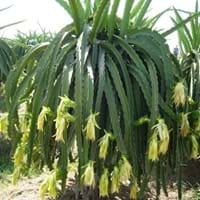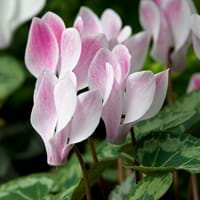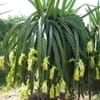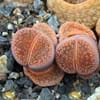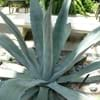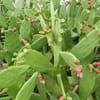Life Span
Perennial
Perennial
Type
Cactus, Fruit
Flowering Plants, Tubers
Origin
Caribbean, Central America
Europe, Mediterranean Basin, Middle East, North Africa, Somalia
Types
Hylocereus undatus, Hylocereus costaricensis, Hylocereus megalanthus
Cyclamen Africanum, Cyclamen Alpinum, Cyclamen Cilicium, Cyclamen Coum
Habitat
Rocky areas, Terrestrial
Alpine Meadows, Rocky areas, Woods
USDA Hardiness Zone
11-15
5-9
Sunset Zone
H1, H2, 21, 22, 23, 24
15, 16, 17, 18, 19, 20, 21, 22, 23, 24
Habit
Spreading
Clump-Forming
Flower Color
White, Gold
Pink, Purple, White
Flower Color Modifier
Bicolor
Not Available
Leaf Color in Spring
Not Available
Several shades of Green
Leaf Color in Summer
Not Available
Not Available
Leaf Color in Fall
Not Available
Green, Silver
Leaf Color in Winter
Not Available
Green, Silver
Leaf Shape
Toothed
Heart-shaped
Plant Season
Summer, Fall
Autumn, Spring, Summer, Winter
Sunlight
Full Sun
Indirect sunlight
Type of Soil
Loam, Sand
Clay, Sandy, Well drained
The pH of Soil
Acidic, Neutral, Alkaline
Acidic
Soil Drainage
Well drained
Well drained
Bloom Time
Early Summer, Summer
Autumn, Spring, Summer
Tolerances
Drought
Not Available
Where to Plant?
Container, Ground, Pot
Container, Ground, Pot
How to Plant?
Cuttings, reseeds, Stem Cutting
From bulbs, Seedlings
Plant Maintenance
Medium
Medium
Watering Requirements
Average Water Needs, Keep the Soil well drained
Do not water frequently, It cannot sustain wet-feet, Keep the ground moist but not water-logged, Prefer drip-irrigation instead of Over-head watering, Water when soil is dry
In Summer
Lots of watering
Lots of watering
In Spring
Moderate
Moderate
In Winter
Average Water
Average Water
Soil pH
Acidic, Neutral, Alkaline
Acidic
Soil Type
Loam, Sand
Clay, Sandy, Well drained
Soil Drainage Capacity
Well drained
Well drained
Sun Exposure
Full Sun
Indirect sunlight
Pruning
Remove damaged leaves, Remove dead branches, Remove dead leaves
Cut or pinch the stems, Prune if you want to improve plant shape, Prune ocassionally, Prune to control growth, Prune when plant is dormant, Remove dead leaves, Remove dead or diseased plant parts
Fertilizers
All-Purpose Liquid Fertilizer
All-Purpose Liquid Fertilizer
Pests and Diseases
Red blotch
Aphids, Botrytis Cinerea, Gray mold, Mice, Mites, Root weevil, Slugs, Snails, Squirrels
Plant Tolerance
Drought
Drought
Flower Petal Number
Semi-Double
Single
Foliage Texture
Bold
Medium
Foliage Sheen
Not Available
Matte
Attracts
Not Available
Not Available
Allergy
no allergic reactions
Respiratory problems
Aesthetic Uses
As decorated salad, Beautification
Showy Purposes
Beauty Benefits
Not Available
Not Available
Environmental Uses
Air purification
Air purification
Medicinal Uses
Antidiabetic, Appetite enhancer, increase memory, Weight loss
Digestive disorders, Menstrual Disorders
Part of Plant Used
Fruits
Root, Stem
Other Uses
Not Available
Showy Purposes, Used as an ointment
Used As Indoor Plant
Yes
Yes
Used As Outdoor Plant
Yes
Yes
Garden Design
Container, Feature Plant, Houseplant, Rock Garden, Wall, Tropical
Not Available
Botanical Name
HYLOCEREUS undatus
Cyclamen Persicum
Common Name
Pitahaya, Dragon fruit, Night blooming Cereus, Strawberry Pear, Belle of the Night, Cinderella Plant, Jesus in the Cradle
Cyclamen or Florist's Cyclamen
In Hindi
Red Pitaya
Sikalemen
In German
Drachenfrucht, Distelbirne
Zyklamen
In French
pitaya, fruit du dragon, cierge-lézard, poire de chardon
Cyclamen
In Spanish
pitahaya roja (Colombia, Mexico, Venezuela); flor de caliz, pitajava (Puerto Rico); junco, junco tapatio, pitahaya orejona, reina de la noche, tasajo (Mexico)
Ciclamen
In Greek
Φρούτο του δράκου (fruto tu draku)
κυκλάμινο
In Portuguese
pitaia, cato-barse, cardo-ananaz, rainha da noite
Cíclame
In Polish
Red Pitaya
Cyklamen
In Latin
Red Pitaya
Cyclamīnos
Phylum
Magnoliophyta
Anthophyta
Class
Magnoliopsida
Dicotyledonae
Order
Caryophyllales
Ericales
Family
Cactaceae
Primulaceae
Genus
Hylocereus
Cyclamen
Clade
Angiosperms, Core eudicots, Eudicots
Not Available
Tribe
Cacteae
Cyclamineae
Subfamily
Cactoideae
Myrsinoideae
Number of Species
Not Available
Importance of Red Pitaya and Cyclamen
Want to have the most appropriate plant for your garden? You might want to know the importance of Red Pitaya and Cyclamen. Basically, these two plants vary in many aspects. Compare Red Pitaya and Cyclamen as they differ in many characteristics such as their life, care, benefits, facts, etc. Every gardener must at least have the slightest clue about the plants he wants to plant in his garden. Compare their benefits, which differ in many ways like facts and uses. The medicinal use of Red Pitaya is Antidiabetic, Appetite enhancer, increase memory and Weight loss whereas of Cyclamen is Digestive disorders and Menstrual Disorders. Red Pitaya has beauty benefits as follows: Not Available while Cyclamen has beauty benefits as follows: Not Available.
Compare Facts of Red Pitaya vs Cyclamen
How to choose the best garden plant for your garden depending upon its facts? Here garden plant comparison will help you to solve this query. Compare the facts of Red Pitaya vs Cyclamen and know which one to choose. As garden plants have benefits and other uses, allergy is also a major drawback of plants for some people. Allergic reactions of Red Pitaya are no allergic reactions whereas of Cyclamen have Respiratory problems respectively. Having a fruit bearing plant in your garden can be a plus point of your garden. Red Pitaya has showy fruits and Cyclamen has no showy fruits. Also Red Pitaya is not flowering and Cyclamen is flowering. You can compare Red Pitaya and Cyclamen facts and facts of other plants too.
